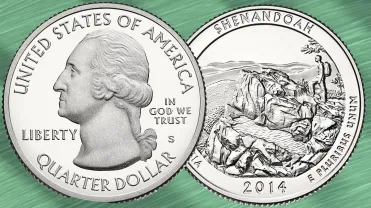Have you ever wondered if the change rattling around in your pocket might be worth more than you think? While most of us don’t give much thought to our spare quarters, some of these seemingly ordinary coins can be worth a small fortune! That’s right—there are rare quarters out there that collectors are willing to pay top dollar for. So, what makes a quarter valuable, and how can you tell if you have a rare one?
Let’s dive into the fascinating world of rare quarters, exploring what makes them unique, how to spot them, and why they’re worth more than just 25 cents.
What Makes a Quarter Rare?
Before we jump into the specifics of which quarters are worth looking out for, let’s start with the basics: What makes a quarter rare? There are several factors that determine a coin’s rarity, and they usually revolve around the following elements:
- Low Mintage: If fewer coins were produced in a given year, they’re harder to find today, making them more valuable.
- Mint Errors: Sometimes, mistakes happen at the mint, resulting in coins with unique characteristics. These errors can significantly increase a quarter’s value.
- Condition: Quarters that are well-preserved or in pristine condition are far more valuable than those that have been worn down through circulation.
- Historical Significance: Some quarters have a special place in history, either because of the year they were minted or the design they carry.
The 1932-D and 1932-S Washington Quarters
One of the most well-known examples of rare quarters comes from the 1932 Washington quarter series. That year marked the 200th anniversary of George Washington’s birth, and to commemorate the occasion, the U.S. Mint produced a new quarter design featuring Washington’s profile. While most of these quarters aren’t considered rare, two specific versions—those minted in Denver (marked “D”) and San Francisco (marked “S”)—are highly sought after by collectors.
Why Are They Rare?
In 1932, the U.S. was in the midst of the Great Depression, and demand for new coinage was low. As a result, only a limited number of Washington quarters were produced at the Denver and San Francisco mints. Specifically, only 436,800 were minted in Denver and just 408,000 in San Francisco. Compared to the millions of quarters minted in other years, these numbers are tiny, making the 1932-D and 1932-S quarters extremely rare.
If you happen to find one of these quarters in your collection, it could be worth hundreds or even thousands of dollars, depending on its condition.
The 1970-S Proof Washington Quarter
Another quarter that stands out in the world of rare coins is the 1970-S Proof Washington quarter. At first glance, this coin might seem like any other, but there’s a twist. Some 1970-S quarters were struck on a planchet that had already been used for a Canadian quarter, leading to a fascinating error that collectors love.
Why Is This Error Valuable?
This minting error, where an old planchet was reused, creates a unique combination of features from both U.S. and Canadian coins. These error coins are incredibly rare, and collectors are willing to pay a premium to get their hands on one. Depending on its condition and the prominence of the error, a 1970-S Proof Washington quarter could sell for several thousand dollars.
The 1965 Silver Quarter
Wait, aren’t all quarters after 1964 made of a copper-nickel alloy? Normally, yes. However, there’s a fascinating exception: some 1965 quarters were accidentally struck on leftover silver planchets from the previous year. While most quarters minted after 1964 don’t contain any silver, these rare 1965 silver quarters are an anomaly.
How to Spot a 1965 Silver Quarter
The easiest way to determine if you have a 1965 silver quarter is by looking at its edge. Quarters made from the copper-nickel alloy will have a distinct copper-colored edge, while silver quarters will have a solid silver edge. If you have a 1965 quarter with a silver edge, congratulations—you’ve found a rare and valuable coin!
Because of their rarity, 1965 silver quarters can fetch prices ranging from several hundred to a few thousand dollars, depending on their condition.
The 2004 Wisconsin Quarter: The Extra Leaf Error
The Wisconsin state quarter, part of the U.S. Mint’s State Quarters series, seems like a perfectly ordinary coin. However, in 2004, some Wisconsin quarters were minted with a unique error—a small extra leaf on the corn husk in the design. This error comes in two varieties: the “high leaf” and the “low leaf.”
Why Is This Error So Sought After?
Collectors love error coins, especially when the error is as visible as the extra leaf on the Wisconsin quarter. Both the high leaf and low leaf varieties are rare, and their value has increased over the years as more collectors have sought to add them to their collections. Depending on the condition of the coin and which variety of the extra leaf error it has, a 2004 Wisconsin quarter can be worth anywhere from $100 to $1,500 or more.
The 1999 Delaware Quarter: The Spitting Horse Error
One of the more amusing rare quarters is the 1999 Delaware quarter, which features an error that makes it look like Caesar Rodney’s horse is spitting. This quarter was part of the U.S. Mint’s State Quarters series, and the error occurs because of a die crack near the horse’s mouth.
Why Do Collectors Want It?
This “spitting horse” error is relatively subtle, but it has captured the imagination of coin collectors. The novelty of the error, combined with the fact that not all Delaware quarters have this die crack, makes it a valuable find. Depending on the condition of the coin, the spitting horse quarter can sell for anywhere from $20 to $200.
How to Check Your Quarters for Rarity
Now that you know about some of the rare quarters in circulation, you’re probably wondering how to check if your quarters are valuable. Here are a few tips for getting started:
- Check the Year and Mint Mark: Look at the year your quarter was minted and see if it matches any of the rare dates mentioned above. Also, check for a mint mark (usually found near Washington’s neck). Quarters minted in Denver will have a “D” mark, those from San Francisco will have an “S,” and those from Philadelphia usually won’t have any mint mark.
- Inspect for Errors: Look closely at your quarter for any unusual features, such as extra marks or design elements that don’t seem right. Many valuable error coins aren’t immediately obvious, so it’s worth taking a closer look.
- Consider the Condition: Coins that are in good condition are always more valuable. If your quarter looks well-preserved, with minimal wear and tear, it may be worth more than a quarter that has been heavily circulated.
- Get a Professional Appraisal: If you think you’ve found a rare quarter, it’s always a good idea to have it appraised by a professional coin dealer. They can give you an accurate assessment of your coin’s value and help you decide whether to sell or hold onto it.
Final Thoughts: Could You Have a Rare Quarter?
While it’s unlikely that every quarter in your change jar is a hidden treasure, it’s definitely possible that one or two might be worth more than their face value. Whether it’s a minting error, a low-mintage year, or a silver anomaly, rare quarters are out there waiting to be discovered.
So, the next time you empty your pockets or sift through your coin collection, take a second to look a little closer. You never know—you might just have a rare quarter that could turn your 25 cents into a small fortune!

